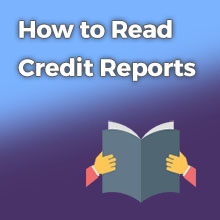How to Read Credit Reports: Useful Explanation

This section will help to understand what your credit reports say. Credit reports are tricky to read so set aside some time for this. I suggest that you make several copies of your credit reports so that you can mark on them and write notes. You don’t want to write on the original.
If you look at the end of your credit reports you will find a key. Spend some time studying the key and you will understand what all of the different codes on the reports represent.
You should get copies of your reports from all four of the major credit reporting agencies. You need to see what all three of these companies are reporting. The following information will help you to understand your reports:
This link will assist you in getting copies of your reports from these four companies: Getting Your Credit Report.
Innovis
Information regarding the Innovis Data Solutions credit reporting agency is hard to come by at this time but I will include a key to their report as one becomes available. In the mean time simply read the report carefully and dispute or question anything that appears to be inaccurate.
Trans Union
Negative listings are as follows
- any inquires
- any listing rated higher than I1, M1 or R1
- any listing of paid profit and loss
- any listing of charge off, repossession, foreclosure, profit and loss write off
- any listing of write off, settled for less than full balance, settled, charge off, included in bankruptcy
- any listing of collection account even if it shows paid collection
- any listing showing 30, 60 or 90 day late payment in the column on the right
- any listing of court accounts such as bankruptcy chapters 7, 11 and 13, divorce, lien, satisfied lien, judgment or satisfied judgment
Experian
Any listing of inquiry or any listing with an asterisk (*).
Equifax
Negative listings are as follows
- any inquiries
- any listing rated higher than I1, M1 or R1
- any listing of court accounts such as bankruptcy chapter 7, 11 and 13, divorce, lien, satisfied lien, judgment or satisfied judgment
- any listing where you see >>>>
- any listing of charge off, paid charge off, settled, settled for less than full balance, paid profit and loss write off, repossession, foreclosure, included in bankruptcy
- any listing of a collection account even if it shows paid collection
- any listing showing 30, 60 or 90 day late payments in the column on the right
| Equifax Credit Report Codes Key |
R = Revolving Account
(credit cards)
I = Installment Account
(car loans or home loans)
R1 or I1 = pays as agreed
or 0 late payments
R2 or I2 = 30 days late
R3 or I3 = 60 days late
R4 or I4 = 90 days late
R5 or I5 = 120 days late
R7 or I7 = making regular payments
under wage earner plan
R8 or I8 = repossession
R9 or I9 = charge off
|
Also, see our page on Credit and FICO Scores to better understand the scoring system that creditors use to rate your creditworthiness.





For Trans Union , presumably M1 is mortgage and “pays as agreed”